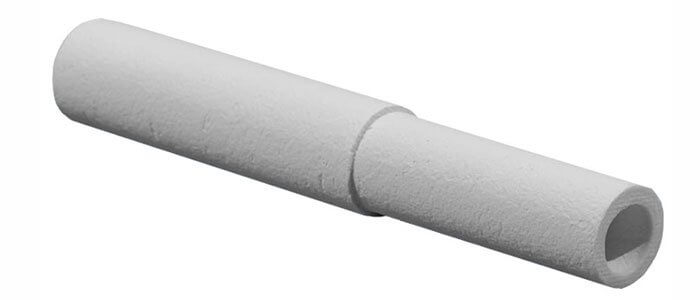Ceramic fiber tubes are a remarkable product in the realm of high-temperature insulation and heat containment. With applications ranging from industrial furnaces to aerospace technologies, ceramic fiber tubes play a crucial role in maintaining thermal efficiency.
I. Ceramic Fiber Tubes: An Overview
Composition: Ceramic fiber tubes are typically composed of high-purity alumina-silica fibers, chosen for their excellent thermal stability and insulating properties. The fibers are woven or wound into a tubular form, creating a lightweight and durable structure.
Applications: Ceramic fiber tubes find extensive use in high-temperature environments such as industrial furnaces, kilns, and various heat containment systems. Their ability to withstand extreme temperatures, thermal shock, and corrosive atmospheres makes them indispensable in applications where conventional materials might fail.

Advantages of Ceramic Fiber Tubes:
a. High Thermal Insulation: Ceramic fiber tubes exhibit exceptional thermal insulation properties, minimizing heat loss and ensuring efficient energy utilization in heat-intensive processes.
b. Lightweight and Flexible: The lightweight nature and flexibility of ceramic fiber tubes allow for easy installation and adaptation to complex shapes, making them versatile in various industrial applications.
c. Resistance to Chemicals: These tubes are often resistant to chemical attack, ensuring stability in the presence of corrosive substances, which is a critical factor in industries such as chemical processing.
d. Low Thermal Mass: The low thermal mass of ceramic fiber tubes enables rapid heating and cooling cycles, contributing to energy efficiency and process optimization.
II. Paper Runners: A Comparison
Composition: Paper runners, in contrast, are typically made from cellulose fibers or other paper-based materials. While cost-effective, they lack the high-temperature resistance of ceramic fiber tubes.
Applications: Paper runners are commonly used as disposable, temporary solutions for low-temperature applications, such as packaging, disposable tableware, and lightweight construction projects.
Advantages of Paper Runners:
a. Low Cost: Paper runners are generally more affordable than ceramic fiber tubes, making them a cost-effective choice for short-term or low-temperature applications.
b. Ease of Disposal: Being made of biodegradable materials, paper runners are easy to dispose of and are environmentally friendly compared to certain alternatives.
c. Flexibility: Paper runners can be easily cut, folded, and manipulated, providing flexibility in design and application.
III. Comparison:
Temperature Resistance:
Ceramic fiber tubes excel in high-temperature environments, while paper runners are limited to low-temperature applications due to their combustion risk.
Durability:
It is durable and resistant to thermal shock and chemical exposure, whereas paper runners are less durable and may degrade when exposed to moisture.
Weight and Flexibility:
It is lightweight and flexible, suitable for various installations. Paper runners are also lightweight but lack the same flexibility in high-temperature environments.
Cost:
While ceramic fiber tubes may have a higher upfront cost, their durability and high-temperature resistance often make them more cost-effective in the long run compared to disposable paper runners.
Conclusion:
Ceramic fiber tubes stand as a superior choice in high-temperature insulation applications, offering unparalleled thermal resistance, durability, and versatility. While paper runners have their advantages in low-temperature and cost-sensitive applications, the unique properties of the tubes make them an indispensable solution in industries where extreme temperatures and longevity are paramount. The choice between the two ultimately depends on the specific requirements of the application at hand.


